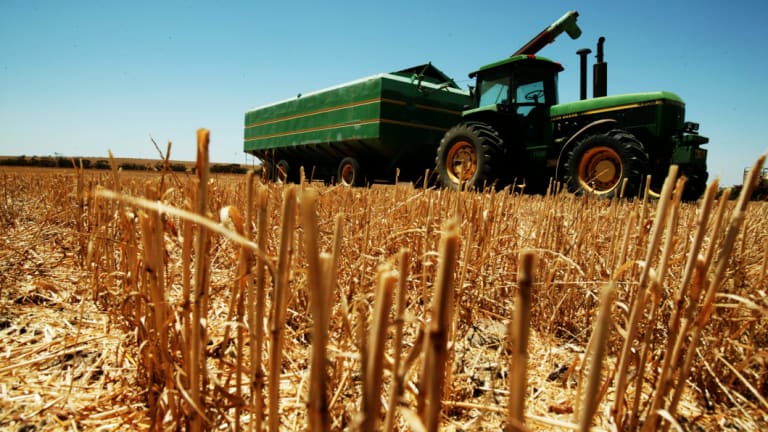Australia
cuts wheat harvest forecast to 10-year low on drought

SMH,
4
December, 2018
Australia
has lowered its wheat production forecast by 11 per cent to the
smallest in a decade amid a crippling drought across the country's
east coast that may cut exports from the world's fourth biggest
supplier.
Wheat
production during the 2018-19 season will total 16.95 million tonnes,
the Australian Bureau of Agricultural and Resource Economics and
Sciences (ABARES). That was below ABARES' September estimate of 19.1
million tonnes, which was on course to be the lowest since 2008 when
output hit just 13.6 million tonnes.
Lower
wheat production will reduce Australia's wheat export capacity,
supporting global benchmark prices that rose to their highest in more
than two months on Monday.
Australia
typically exports two-thirds of its wheat but, with dry weather
hampering local production, demand from domestic millers will
supplant major customers such as Indonesia.
The
outlook also casts a shadow over Australia's economy and its largest
listed bulk grain handler, GrainCorp, which earns most of its
revenues from trading wheat.
GrainCorp
on Monday said it received an unsolicited $2.38 billion takeover
approach from a little-known asset manager. Analysts say the timing
of the offer was opportunistic as the unfavourable weather limited
the bulk grain handler's ability to earn revenue.
Production
in Australia's east coast has been particularly hampered with the
entire state of NSW, the second-largest producing region, hit by
drought earlier this year.
ABARES
said production from NSW would reach 1.98 million tonnes, the lowest
since 1995.
"I've
just finished harvesting a bit of seed but that is about it,
certainly no wheat this year," said Dan Cooper, a farmer in
Caragabal, NSW, located 400 km (250 miles) west of Sydney.
While
the dry weather is unlikely to wilt Australia's wheat crop any
further just weeks before harvest begins, the country's weather
bureau said the drought was expected to continue until early next
year.
Australia's
Bureau of Meteorology sees an 80 per cent chance of
warmer-than-average temperatures between December 1 and February 28.
Warning Queensland heatwave causing erratic snake behaviour after man bitten in bed

TVNZ,
4
December, 2018
Finding
a snake in your bed could be one of the unanticipated consequences of
climate change, animal experts in Australia warn.
The
warning comes after a north Queensland man found himself with a
strange bedfellow over the weekend, with an unknown snake biting him
a number of times on the face.
Tony
Kenwright, from Mackay, went to hospital as a precaution, but it's
believed the snake that bit him was a non-venomous tree snake.
Mackay-based
snake catcher and breeder Brett Modra said it was one of a number of
erratic snake behaviours he's seen recently.
Mr
Modra said heat would affect venomous snakes more than pythons.
Beyond
the current heatwave, the overall warming trend has disrupted snakes'
breeding cycles, meaning there could potentially be more snakes,
acting more aggressively, because they were charged up by the heat.
"So
the likelihood of a venomous snake coming into a dwelling to escape
the heat is probably a lot more than it used to be," Mr Modra
said.
University
of Queensland snake expert Professor Bryan Fry agrees, saying snakes
are the "scaly canaries in the coal mine" warning of deeper
problems in the ecosystem.
"Snake
encounters will go up with this extreme weather as snakes are trying
to escape the heat," Professor Fry said.
Data
on snakebites was surprisingly poor in Australia, he said, as doctors
aren't required to report instances to authorities, but anecdotally
incidents of humans being bitten are rising.
"We're
definitely seeing increases that are paralleling these acute climatic
events such as these recent heatwaves, with snakes trying desperately
to seek shelter from heat that would otherwise kill them."
Over
the weekend Queensland Health issued a warning about the heatwave
affecting snake behaviour.
"There
are reports of increased presentations of people with snake bite,
particularly up north," acting Chief Health Officer Sonya
Bennett said.
Gold
Coast based snake catcher Tony Harrison said he hadn't noticed any
difference in snake behaviour in his area over the last few months,
with southeast Queensland largely spared the severity of the
heatwaves affecting central and northern parts of Queensland.
However
he said the proportion of dangerous venomous snakes to which he was
being called out had risen, because people were better educated about
what types of snakes posed a threat.
"In
the old days people would see something long and thin and call me.
Now they get out their phone, take a picture and ask social media
what it is, and if they get told it's a carpet python they leave it
there," Mr Harrison said.
The
weather bureau's climate outlook for this summer, released last week,
predicts a dry summer with temperatures above average for most of
Queensland and other parts of Australia.
No comments:
Post a Comment
Note: only a member of this blog may post a comment.